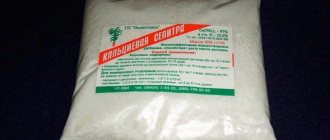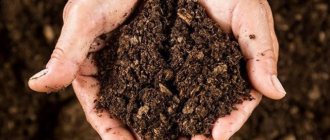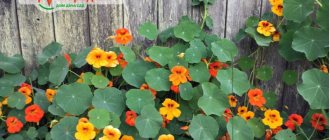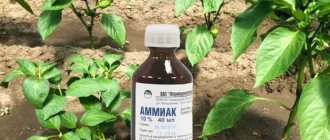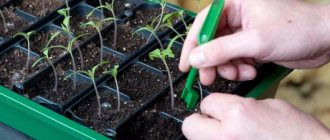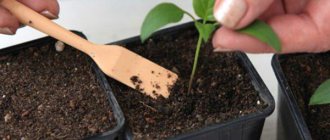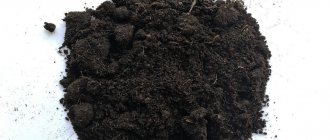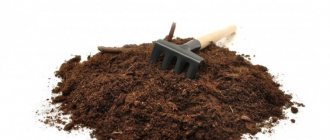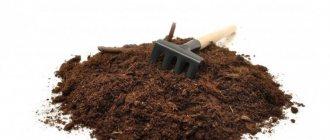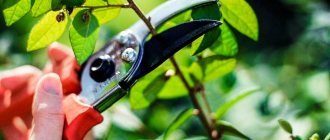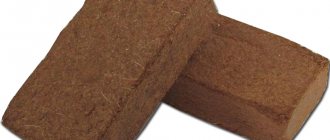In order for peat to benefit your garden, you need to know, firstly, some of its features. Secondly, before using peat, it is necessary to determine the type of soil on the site. Thirdly, this rock must also be introduced into the soil correctly.
Due to its many beneficial properties, peat is used in many areas. Its main use is as fuel. In addition, bedding for animals is made from it and added to feed; thermal insulation blocks are made from peat; Some medications and procedures also cannot do without this mineral. Peat is also used in filters for aquariums; fabrics are already made from it and even whiskey is produced. And finally, peat is used in agriculture. It is the latter option for using peat that interests us most.
Origin and properties of peat
Imagine a body of standing water in which plants and other organisms live. They die and gradually settle to the bottom. This has been happening for many, many, many years. This bottom layer is pressed with water, and this entire process occurs without access to oxygen. This is how peat is formed.
The lower bottom layers are lowland peat, in which the processing process has already been completed. It is a processed substance with a neutral reaction - 5.5-6.5 pH. And the top layer of bottom sediments is high-moor peat, in which decomposition processes are still ongoing, so it has a very acidic reaction - 2.6-3.2 pH.
If you compare low-lying peat with high-moor peat, you can see that processing processes in high-moor peat continue: it is more fibrous than processed low-lying peat, and not as dark. It is very easy to distinguish them. Between these two layers there is an intermediate or middle peat of a slightly acidic reaction.
- Stevia: cultivation, properties, types and varieties
Many gardeners buy peat in large quantities, although a good product is not cheap at all. They scatter it over the beds and tree trunks in anticipation of magical changes, not realizing that peat is not inherently a fertilizer. Yes, it contains useful substances, including nitrogen, but in very small quantities, and besides, peat releases these elements very reluctantly, so it makes no sense to use it as a fertilizer.
What plants is peat suitable for?
The material is used in fields (when growing grain), in vegetable gardens and flower beds. In its pure form, it is most often used for flowers. Hydrangea, Erica, rhododendron, heather love acidic soil, so peat will be useful for them.
Rye prefers acidic soils among grains. Wheat and oats give high yields on acidic soils, but close to neutral (pH 6-7). It is not recommended to apply pure peat to fields; it will not be beneficial. Most often, ready-made industrial fertilizers made on its basis are used here.
Peat-based fertilizers are well suited for garden crops. They stimulate growth and increase the yield of potatoes, cabbage, cucumbers, tomatoes, carrots, sweet peppers, and zucchini. It’s a good idea to use similar fertilizers for greens - lettuce, dill, parsley. It is best to use peat composts or material additionally treated with lime, superphosphate, and potassium chloride in the garden.
Purpose of peat
Peat is primarily used to improve soil structure. Due to its fibrous and clumpy nature, peat introduced into the soil makes it air- and moisture-permeable: it breathes, easily saturates with moisture and retains it. If peat is added to the ground, it is easier for plant roots to develop.
It is not advisable to add peat to humus-rich soil - chernozem, loamy or sandy loam. Poor soils need to be improved. For example, my soil is sandy, and adding peat will enrich it.
But the most important advantage of peat is that thanks to it, organic and mineral fertilizers added to the soil are much better absorbed by plants.
What soil is peat suitable for?
There are peat-based fertilizers that can be used on almost all soils. These include extracts, granules, compost cubes. But the material itself, even after processing, is better suited for clay and sandy soil.
Peat increases the porosity of clay soils. Their aeration improves; when they dry out, a crust no longer forms on the surface, preventing the access of moisture and oxygen to the roots of the plants. Clay sometimes has an alkaline reaction, peat increases acidity, making the soil neutral or slightly acidic.
The disadvantage of sandy soil is its high water permeability. After adding peat, moisture is better retained in the upper layers of the soil, and nutrients are no longer washed out. This increases productivity and reduces the amount of watering.
In soddy-podzolic soil, humus degrades quite quickly. After adding peat, this process is suspended. Soluble carbohydrates and nitrogenous compounds become a substrate for the proliferation of beneficial microorganisms. Humic acids trigger biochemical processes that stimulate the formation of humus.
Peat is not suitable for sandy and loamy soils. But in such areas you can use ready-made granular fertilizers or solutions. Their main task is to enrich the soil with organic matter and stimulate plant development.
Peat compost
If you need to improve the soil on your plot or even in one bed, using peat will cost you a pretty penny, but there is a way out: make peat compost. Place a layer of peat at the bottom of the compost heap, and on top of it - a layer of tops, weeds and organic residues from the kitchen, then another layer of peat, and then in the same order.
As a result of rotting, you will get peat compost, which in its nutritional value will be no worse, and maybe even better, than rotted manure. If you do everything correctly, the compost will be loose and the plants will grow well in it. And most importantly, you will receive it in large quantities.
- How to properly care for forsythia (video)
Peat as a fertilizer for vegetable crops
Almost all crops yield good yields when using peat. Tomatoes, sorrel, potatoes, strawberries, strawberries and blueberries react especially favorably to the beneficial substance.
Fertilizing is carried out in the spring, simultaneously with planting potatoes. Peat material mixed with manure is thrown directly into the hole , which allows nutrients to better penetrate to the seeds.
Peat also works well for strawberry growth. The fruits ripen faster and the harvest becomes richer. Planting material has an equally good effect on tomatoes. Fertilizing is carried out once every 14 days using the root or foliar method .
https://ferma.guru/
Peat and moisture
It is almost impossible to spoil the soil or bed with peat. If finances allow you, you can add it to the soil in any quantity. And the norm is four to five buckets per square meter. But there is one important point: the fact is that peat is wet, it is sold in special sealed bags, and under no circumstances should it dry out. Dried peat will take a long time to soak, and this process is not easy, so store it correctly.
The mistake is made by those gardeners who simply scatter peat on the surface: it quickly dries out and loses all its beneficial properties. If you want to mulch a garden bed with peat, you need to scatter it and then work it into the soil.
If you are preparing a bed for planting, spread the peat on it and dig the bed to a depth of 20-25 cm, but if you apply it under the plants, carefully, so as not to damage the roots, mix the peat while loosening it with the soil. And remember to water regularly to keep the peat slightly moist at all times.
How to make your own peat fertilizers
Peat enriched with minerals or fertilizers based on it are much more effective in increasing soil fertility. Making such mixtures yourself is not that difficult.
Main methods:
- Adding mineral components
- Composting
Below we will talk in more detail about these techniques.
Adding mineral components
Most often, ammonia and its compounds (ammonium and ammonium nitrate, ammonium sulfate) are added to peat. It converts peat nitrogen into a mobile form, which is more easily absorbed by plants. This occurs due to the formation of soluble humic ammonia salts. At the same time, the acidity of the peat decreases.
In addition to ammonium, phosphorylite flour or superphosphate (a source of phosphorus), potassium chloride, and potassium salt are added to the material. For alkalization, peat is mixed with dolomite flour or limestone.
Not all components can be used at home. Dry ammonia or ammonia water are not entirely safe compounds. When they are added to peat, the temperature rises as a result of chemical reactions, which can provoke spontaneous combustion. Therefore, it is recommended to independently carry out liming and enrich the peat with minerals.
To reduce acidity, add limestone flour or wood ash.
The amount depends on the type of peat and its pH (calculation per 1 kg of substrate):
- Horse (pH 2.5-3.5) - 350-450 g
- Transitional (pH 3.5-4.5) - 200-350 g
- Low (pH 4.5-5.5) - 100-200 g
To increase the content of potassium and phosphorus, add (per 1 kg of peat):
- Superphosphate - 300-400 g
- Potassium salt - 300-500 g
To enrich with minerals, it is best to use lowland peat with a high degree of decomposition and ash content. All components are thoroughly mixed. Peat with limestone is left for 4-5 months, with potassium and phosphorus - for 2-3 months. After this, it can be applied to the soil.
Enrichment can also be carried out in a layer-by-layer manner. Peat is placed in a stack 20-30 cm thick, sprinkled with lime, superphosphate or potassium salt. The same layer of peat is applied on top. The total height can reach 1-1.5 m. The “ripening” time of the fertilizer is the same as when mixing the components.
Composting
Peat-based composts are easy to prepare at home. They are much more effective than fertilizers with minerals. Organic substances decompose at a temperature of 50-70०С. Under such conditions, the number of mobile forms of nitrogen increases 4-5 times. The degree of absorption of the element by plants increases from 2-3% to 15-25%. Pathogenic microorganisms and helminth eggs are destroyed, beneficial soil flora is activated. Complex carbohydrates (cellulose, pectin, lignin) intensively break down, phosphorus, potassium and other trace elements are released.
For composting we use:
- Peat of any type
- Manure
- Slurry
- Bird droppings
- Kitchen waste
- Plant tops
- Grass
Sometimes limestone flour is added to the material. When using peat with a low mineral content, superphosphate and potassium chloride are added.
To obtain high-quality material, compost should be placed in the pit correctly. Peat humidity should not exceed 60-70%. If slurry is used, the figure should not exceed 40%. In a waterlogged substrate, the temperature decreases, decomposition processes slow down, and in winter it will simply freeze and composting will stop.
For laying, prepare a hole or area fenced with boards. The area of the place must be at least 2x2 m.
The components are laid as follows:
- Peat - 40-50 cm
- Manure - 25-30 cm
- Peat - 40-50 cm
The height of the stack should be 1.5-2 m. The last layer is always made of peat. The material traps nitrogen and prevents the loss of this valuable element. Manure and peat can be mixed evenly, but this method is only suitable for composting in the summer.
Another method of stacking is focal. 50-60 cm of peat is poured into the bottom of the pit. Small piles of manure, up to 40-50 cm high, are placed on top in a checkerboard pattern. Then they are completely covered with peat. The total height of the stack should be about 1.5-2 m. The focal stacking method is well suited for winter composting. The temperature inside the heap remains high even in severe frosts.
If there is no manure on hand or there is very little of it, humus can be made in another way. In summer, tops, grass, and food waste are placed on a layer of peat 40-50 cm thick. The pit is periodically watered with mullein. Add 5 kg of cow dung to a bucket of water and mix thoroughly. Manure can be replaced with bird droppings (0.5 kg dry or 2 kg fresh per bucket of water). When the waste pile reaches a height of 20-30 cm, it is covered with peat or mixed with the bottom layer. For the winter, you need to lay a peat cushion on top.
To enrich the compost, 1.5-2% superphosphate and 0.5% potassium chloride of the total mass are added to it. For 100 kg of compost you will need 1.5-2 kg of phosphorus fertilizer and 0.5 kg of potash. If acidic high peat is used, add 1-2% limestone flour (1-2 kg per 100 kg of substrate).
Compost matures in 2-9 months, depending on the season. When laying a hole in the spring, you can add it to the ground in the fall.
My plans for peat
I purchased peat for planting. The planting hole needs to be filled with a fertile mixture so that for the first two to three years, that is, the most important period in their lives, the seedlings can actively and without much effort develop the root system. And peat is one of the most important ingredients of a fertile mixture, especially in areas with sandy soil. Peat makes it easier for roots to penetrate the soil in all directions. I will also need peat for planting seedlings in containers.
I also bought a bag of high-moor, that is, sour peat. I need it for plants that prefer to grow in acidic soil - hydrangeas, heathers, rhododendrons and azaleas. Rather than adding citric acid or special fertilizers to their soil, it is better to add high-moor peat to it.
Study the preferences of your plants, dig a large and wide hole and fill it with a mixture suitable for them. It will not be enough for their entire life, but the most important thing in the life of seedlings is the first 2-3 years; this amount of mixture will be enough for them to develop the root system. And in the future, all the components necessary for growth can be added: loosen the soil or remove its top layer, lay in the necessary components, mix them with the soil and seal them.
I hope you find this information useful and I wish you all the best.
- Yaskolka: growing and care in the garden
Industrial fertilizers based on peat
Peat of all types is used for industrial fertilizers. The composition of the feedstock is analyzed in the laboratory. Its acidity, content of basic nutrients, degree of decomposition, humidity, and moisture capacity are determined. Then mineral or organic substances are added.
Based on their composition, industrial fertilizers are divided into:
- Peat ammonia (TAU)
- Peat-mineral-ammonium (TMAU)
- Peat minerals (TMU)
Peat ammonia (TAU)
Produced on the basis of all types of peat. Pure ammonia or ammonia water is added to the mixture. The amount depends on the acidity and ammonia absorption capacity of the peat. The chemical is mixed with the material in the piles or during the mining process (during the milling stage). Ammonia activates nitrogen, making it available to plants. The acidity of peat is reduced, which is why any type of peat can be used for the production of fertilizers.
TAUs have growth promoting properties. They increase the yield of potatoes and vegetables by 15-20%, grains by 10-15%. On mineral-poor soils, they must be applied together with potassium and phosphorus fertilizers.
Peat-mineral-ammonium (TMAU)
To produce this type of fertilizer, peat of any type is used with a degree of decomposition of at least 15% and an ash content of up to 25%. The amount of iron in it should not exceed 1%. In addition to ammonia, phosphorus and potassium are added to the mixture. These components are most often added during the milling process, and ammonia solutions are added directly to the piles. Fertilizer promotes the proliferation of beneficial microflora in the soil, activates biochemical processes, and stimulates the formation of humus.
TMAU is the most effective peat-based fertilizer. In the first year they increase the yield by 45-60%, in the second - by 25-40%, in the third - by 10-15%. It is best to apply them under potatoes and vegetable crops, berry bushes and fruit trees.
Peat minerals (TMU)
For the production of fertilizers, lowland and transitional peat with a pH of 3.5-5.5, a degree of decomposition of more than 15% and an ash content of up to 25% are used. The iron content should not exceed 1%. The material is mixed with limestone or dolomite flour, phosphorus and potash fertilizers. The effectiveness of fertilizers is lower than that of ammonia fertilizers. But the manufacturing process is safe and not so labor-intensive. Fertilizers are most often used in forest nurseries and on sandy and sandy loam soils.
The listed types of fertilizers are prepared directly in the fields or in piles. Then they are dried to a humidity of 40-60% and packaged in polyethylene containers. Sold in both large (20-30 kg) and small (0.5-3 kg) bags. In some farms, the material is simply shipped without additional packaging.
Peat-based fertilizers can be subject to additional processing. According to this principle they are divided into:
- Granular
- Peat humus granulated
- Peat-humic extracts
Granular
Fertilizers are made from milled peat. Limestone flour, ammonia, and minerals (potassium, phosphorus) are added to it. Then the material is dried and formed into granules, packaged in 0.5-2 kg plastic bags. The fertilizer is stored for about two years.
Peat humus granulated
High-moor peat or a mixture of high-moor and low-moor peat is used. The material can be limed, and microelements (potassium, phosphorus, magnesium, manganese) are added if necessary. Then the peat is mixed with humus, horse manure, mullein, and turf soil. The mixture is dried, pressed into bars, from which they are cut into cubes.
The fertilizer is well suited for growing fruit and berry crops - apple trees, pears, sea buckthorn. The cubes are placed in the holes before planting cuttings and seedlings. They would also be good for cucumbers, tomatoes, peppers, cauliflower and other vegetables.
Peat-humic extracts
Extracts are obtained after preliminary activation of nitrogen. To do this, add alkalis or anhydrous ammonia. Nitrogen salts of humic and some other organic acids (acetic, formic, succinic) are formed in peat. Substances act as plant growth stimulants.
The resulting humate extract is packaged in a special container. Fertilizers can be used to treat seeds and cuttings before planting and stimulate seedling growth. They are useful for indoor flowers and greenhouse plants.
Peat granular fertilizers and extracts are applied to the soil in small quantities. Their main role is to start the process of humus formation and activate soil flora. They also replenish microelements in the soil.
Peat for the garden: the benefits and harms of raw materials
Gardeners use peat raw materials to impart looseness to the earthen coma and create the correct structure of sod-podzolic soils, where sand and clay predominate. As you know, sand holds water poorly, while clay is airtight.
Therefore, there is no better option for such soil. How to choose peat for the garden? You can choose depending on the degree of decomposition of the substance. There are three categories:
- Lowland type. More than 40% decomposition rate. Due to its neutral composition, it is best suited for the garden.
- Transitional type. The degree of decomposition is from 25 to 40%. Used as composting material.
- Horse type. The minimum degree of decomposition, which is 20%. It is not recommended to apply it in its pure form to the soil due to its high acidity; it requires pre-treatment.
The main benefits and harms of peat on a garden plot. Let’s determine what the beneficial effects of the peat composition are:
- Allows you to increase productivity by improving the soil, with minimal costs.
- Increases the humus layer of the soil, thereby improving fertility.
- Increases porosity, air and water permeability of the substrate, improving the functioning of the root system of plants.
- Fights pathogenic microflora, fungi, bacteria, and is a good antiseptic.
- If the acidity of the substrate is low, this indicator can be normalized if you choose the right type of peat.
- It quickly warms the ground, is able to retain useful substances and stop their leaching.
- It is hygroscopic. Increases soil moisture capacity.
What disadvantages and harm can it bring:
- Peat is harmful only if it is used incorrectly or combined with low-quality fertilizers. Then the plants slow down their development, and in some cases even death is possible.
- The substance can increase soil acidity, which has an adverse effect on crop growth. To avoid acidification of the soil, lime the peat material - add 4–6 kg of lime per 100 kg.
- Peat will not bring any benefit if the soil is fertile and loose. The content of microelements in the substance is minimal and will only be absorbed by 5%. This should be taken into account.
Peat as a fertilizer for vegetable crops
Almost all crops yield good yields when using peat. Tomatoes, sorrel, potatoes, strawberries, strawberries and blueberries react especially favorably to the beneficial substance.
Fertilizing is carried out in the spring, simultaneously with planting potatoes. Peat material mixed with manure is thrown directly into the hole , which allows nutrients to better penetrate to the seeds.
Peat for garden plants
Each garden crop has its own requirements for soil acidity and fertility. Therefore, with a competent approach, you need to use different compositions for fertilizer. An exception is for a universal soil mixture that will suit most plants.
Components used:
- fertile soil - 2 parts;
- compost - 1 part;
- lowland peat - 1 part;
- river sand - 1 part;
- Azofoska - 50 mg.
Mix all components thoroughly until a homogeneous composition is obtained. The composition can be strengthened by adding wood ash at the rate of 100 g/5 kg of the mixture. The prepared mixture is used for mulching under plants or growing seedlings.
Peat for zucchini, pumpkins, cucumbers
Cucumbers, like pumpkins, respond positively to organic fertilizers, and therefore peat in combination with compost can increase yield and average fruit size. Two types of composition are widely used:
- Bottom peat, rotted manure, rotted sawdust in a ratio of 2:1:1.
- Compost, soil from the garden, leaf soil, peat in equal parts.
Leaf soil can be collected from any deciduous tree with the exception of oak, chestnut and walnut. Before adding to the mixture, it is advisable to disinfect the soil with fungicides.
Peat soil mixture is best used for growing seedlings.
Peat for pepper and tomato
Tomato and pepper seedlings are the most demanding in terms of soil nutrition and may not succeed if you take soil from the garden. The situation is saved by a mixture of the following components:
- humus;
- fertile soil;
- river sand;
- peat.
All components are taken in equal parts, peat - 0.5 parts. After mixing, you can add a glass of wood ash per 10 kg of mixture and mix thoroughly again. The resulting composition can be used to fill cups for growing seedlings.
Do not get carried away with peat when growing peppers and tomatoes - it can slow down their growth.
Peat for cabbage
Cabbage leaves are particularly demanding regarding the nitrogen content in the soil, without which the formation of dense, tight heads of cabbage is impossible. Therefore, a simple mixture is used in which peat and humus are combined in equal parts. You can also use peat-liquid compost mixed with soil from the garden in equal proportions.
As soon as the head begins to form, the cabbage's need for nitrogen decreases slightly, but more potassium is needed - it is responsible for the taste and curling of cabbage leaves. Therefore, at this stage, the plant is fertilized not with peat, but with potassium mixtures.
It is important not to overdo it with the addition of peat: it acidifies the soil, and therefore many plants will wither. For this reason, it is recommended to undergo soil tests before using peat fertilizers. If it belongs to chernozem and other fertile species, such fertilizer should not be used.
What benefits and harm can peat bring to the garden?
Over time, any soil becomes depleted and requires systematic fertilization, otherwise growing crops on it becomes difficult.
In this case, gardeners resort to fertilizing the substrate with organic substances. One of these is peat - a natural fertilizer formed from particles of dead bog plants. Peat, as a mineral, is mined in swamps, river beds or watersheds.
This type of raw material has been used for a long time as the basis of fertilizers for the land and in other fields of activity. The substance consists of decomposed plants and synthesis products - humus, mineral particles and water. The composition also contains a small amount of mineral and chemical elements.
How much peat to add to the soil
To increase soil fertility, add 5–10 kg of lowland peat per 1 sq. m. m. Peat composts are added in an amount of 3–4 kg per 1 sq. m. m, but on moderately fertile soil you can limit yourself to 1–2 kg.
To improve the structure of clay soil, 1–3 buckets of high-moor or transitional peat are embedded in it. This is approximately 10–30 kg per 1 sq. m. In sandy soil to improve its physical properties per 1 sq. m add 1 bucket.
If the peat is neutralized, it can be applied both in autumn and spring. If calcareous materials are added to the soil along with it for deoxidation, then it is better to do this in the fall so that all the necessary reactions have time to occur.
Why compost peat
Any peat after composting becomes a more valuable fertilizer. For example, peat manure compost contains even more nitrogen than pure manure. In addition to manure, peat is mixed with chicken droppings, green plant matter, ash, lime materials or mineral fertilizers. Sometimes it is useful to add clay to it.
When manure and other nitrogen-rich organic matter are added to peat, many decomposing microorganisms appear in it. Decomposition occurs more intensively, and previously inaccessible nitrogen quickly takes on a form available to plants. In addition, manure enriches peat with potassium and phosphorus.
Lime fertilizers are added primarily to deoxidize the peat. After this, it can be applied to acidic or neutral soil. Liming peat is also useful because it speeds up its decomposition. In an acidic environment, decomposing bacteria do not develop, and after neutralization they begin to actively work.
Lime materials bring another positive effect. Peat gets rid of the unpleasant property of repelling water when it dries out and begins to absorb moisture like regular soil. Adding clay gives the same result. However, if you plan to fertilize heavy soil with peat compost, you should not add clay to it.
When ash is added to peat, it not only deoxidizes a little, but is also enriched with a large number of useful elements. Ash contains almost everything that plants need except nitrogen, and all of these substances will end up in the compost.
Mineral fertilizers are added mainly to compensate for the lack of phosphorus and potassium in peat. Phosphorite flour also deoxidizes it a little.
Comparison
You can understand the value of this mineral in comparison with organic fertilizers:
- humus and manure;
- black soil;
- chicken droppings.
Humus and manure
The main difference is acidity. Peat wins here, so it is used for depleted land. But in most cases, humus is used, since it contains more nutrients necessary for plant growth.
Chernozem
Chernozem contains a large amount of humus, but it also contains more pathogenic bacteria and viruses. Therefore, the summer resident has to choose independently based on what the soil lacks. If you add peat, it must be diluted with sand and perlite and humus.
Chicken droppings
Chicken droppings benefit from the fact that they are more valuable in terms of the composition of nutrients. Some gardeners prefer to use droppings.
Common mistakes
If the technology of use is violated, fertilizing can cause harm. The introduction of the substance in large quantities provokes an increase in soil acidity, as a result of which crop growth slows down. The most common mistakes gardeners make due to lack of experience:
- Fossils completely replace all mineral supplements. As a result, plants “starve”, faced with a lack of individual components.
- Failure to comply with dosages - acidity decreases to a minimum or increases sharply.
- Failure to compost – individual plants cannot obtain nutrients.
- Overdrying peat - it becomes useless.
- Use in fertile areas.
If peat is properly applied to the soil, it will serve as a fertilizer. If you violate the basic recommendations, fertilizing will have a negative effect on the growth and development of crops. For potatoes and flowers, acidity is not important. Cucumbers, zucchini, tomatoes and cabbage are more demanding: an excess of the component will slow down growth. Fruiting may not occur, the crops will die.
Where can I get peat for a garden in nature for free?
In wetlands, you can extract peat yourself without spending money on buying it. To do this, you need a sharpened shovel and a vehicle with a trailer.
First you need to remove the top layer of a few centimeters with a shovel. Then you can start loading the peat into the trailer. After delivery to the site, the peat must be dried and then used as fertilizer.
Peat extraction.
Types of peat
According to the institute's research in the European part of the Soviet Union, there are 38 species. But all these types are combined into 3 types, which are divided based on the properties of the peat and the nature of the waters that feed the swamps.
- Lowland.
- Horse.
- Transition.
Lowland peat
Fed by groundwater. Its pH is neutral or slightly acidic. In total, it contains 70% organic residues; in addition, it contains a large amount of minerals.
Lowland peat is often used to improve the soil composition of soil that has been used for a long time without applying any fertilizers.
High peat
Of all types, it is the most infertile, therefore it is only suitable for mulching or plants that require high soil acidity for growth and development.
It contains sphagnum moss, pine, cotton grass and a certain amount of moisture. There are also no parasites or weed seeds. These qualities are especially valuable for those summer residents who have greenhouses.
Transitional peat
The middle formation is between low-lying and high-moor peat, that is, the layer is transitional. With fewer microelements and low soil acidity. The plant remains that make up this species are almost constant, differing slightly, depending on the type of peat deposits.
Neutralized peat
Subspecies of the riding species. It is used for the preparation of substrates; for this, raw materials with a low degree of decomposition are taken. In this case, limestone flour is used to neutralize acidity.
It is used to make greenhouse soil, or soil for plants grown in pots. For open ground, used when planting trees and shrubs.
